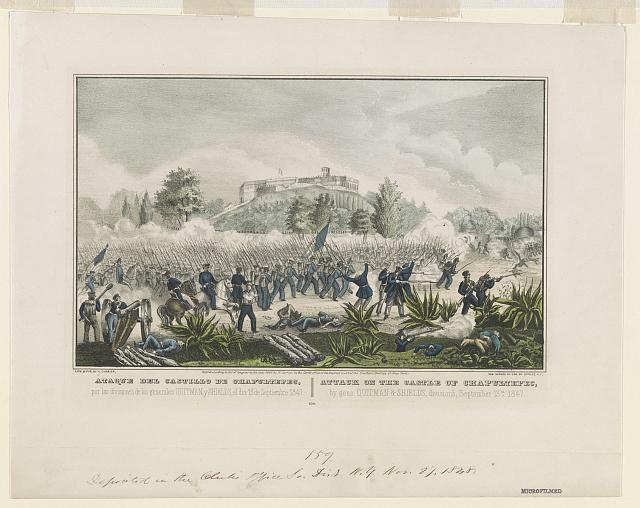The "Brave Rifles:" 3d U.S. Cavalry

In the spring of 1846, Congress authorized the establishment of a new military unit, the Regiment of Mounted Riflemen. Unlike the two existing regiments of United States Dragoons, the primary combat role of the mounted riflemen differed from their Dragoon counterparts. While the Dragoons fought on foot as infantry and could perform the traditional acts of reconnaissance and screening associated with cavalry, the Riflemen would fight dismounted and use their horses as transportation between various points on the battlefield.

Recruiting depots were established at Fort McHenry in Baltimore and Jefferson Barracks, Missouri. With the United States at war with Mexico, the regiment was ordered south late in the fall of 1846. Unfortunately, many of the unit’s horses were lost at sea during the journey, and all but two companies would fight dismounted in the upcoming campaign. The regiment landed at Vera Cruz in March 1847 under the command of Maj. Edwin V. Sumner. A former member of the 1st U.S. Dragoons, Sumner would later command the 2nd Corps of the Army of the Potomac during the Civil War.
Assigned to Maj. Gen. Winfield Scott’s army, the unit fought in the Mexico City Campaign. At the Battle of Cerro Gordo, the Riflemen lost 13 men killed and 71 wounded, among them Maj. Sumner. On September 13, elements of the regiment made up the storming party on the fortress of Chapultepec outside of the enemy capital. The next morning, Capt. Benjamin Roberts and Sgt. James Manly of Company F raised the United States flag over the National Palace inside the city while Capt. Andrew Porter placed the regiment’s standard on the balcony.

After the war, the Riflemen were assigned to duty in the Oregon Territory. Beginning in December 1851 all but one squadron was transferred to Texas. Over the next several years the Riflemen participated in skirmishes with the Comanche and Lipan Indians before moving to the New Mexico Territory. There, the Riflemen engaged in operations against the various Apache tribes and five companies participated in the Navajo War. One of the regiment’s officers who was wounded in this struggle was William Woods Averell. A future Union cavalry commander; Averell is best known for leading the Federal mounted forces at the Battle of Kelly’s Ford in March of 1863. The American Battlefield Trust has managed to preserve over 1,300 acres at Kelly’s Ford.

When the Civil War broke out, the regiment remained in the west. By an act of Congress in the summer of 1861, the regiment transitioned from its role of mounted infantry to become the 3rd United States Cavalry. In February 1862, several companies fought at the Battle of Valverde. A little over a month later, elements from the 3rd U.S. were heavily engaged at the Battle of Glorieta Pass. Through the efforts of the American Battlefield Trust, 19 acres of this battlefield have been saved, making it the farthest section of preserved land beyond the Mississippi River. At the end of the year, two squadrons were sent east and temporarily assigned to the 15th Corps in the Army of the Tennessee. These troopers were present at Chattanooga in the fall of 1863 and conducted a reconnaissance to Knoxville that winter. The regiment was assigned to Little Rock, Arkansas in the summer of 1864 where it combated local guerrillas until the Confederacy capitulated.
In the early spring of 1866, the 3rd U.S. returned to New Mexico. After nearly four years of service, the regiment was transferred to Arizona and once again engaged the Apaches. While on a scouting expedition in May 1871, Lt. Howard Cushing of Company F was killed in action against the Chiricahua warrior Geronimo. One of the best officers in the regiment, Howard was the brother of Alonzo Cushing, who received a posthumous Medal of Honor for his actions at Gettysburg and Commander William Cushing, famous for his raid on and destruction of the CSS Albemarle in the fall of 1864.
Transferred to the Department of the Platte in 1872, the regiment later fought in the Great Sioux War. At the Battle of the Rosebud on June 17, 1876, the commander of Company D, Capt. Guy V. Henry, was wounded. Henry would eventually receive a Medal of Honor for his actions at Cold Harbor during the Civil War. Although the Trust has saved over 100 acres at Cold Harbor, the battlefield remains a focal point of its preservation efforts. In 1882, the regiment was again posted to Arizona where it eventually assumed operations against its old nemesis, Geronimo.
When war broke out with Spain near the close of the nineteenth century, the regiment was dispatched to Cuba. During the Santiago Campaign, three troops of the 3rd participated in the famous assault on San Juan Heights. Early in the fall of 1899, the regiment was sent to the Pacific and fought in the Philippine Insurrection. Over the next three years, the 3rd took part in over 60 battles and skirmished on the island of Luzon.
Upon the United States’ entrance into World War I, the regiment sailed to France as part of the American Expeditionary Force. Elements of Troop K fought in the Aisne-Marne Operation. All of Troop K saw action at Vesle, Oise-Aisne and in the Meuse-Argonne. Re-designated the 3d Cavalry Group at the beginning of 1943, the unit served under one of its former colonels, George S. Patton in the Third Army during World War II. Three years after the end of the conflict, the unit went through another re-designation to the 3d Armored Cavalry Regiment (ACR). The unit served in Operations Desert Shield, Desert Storm, Iraqi Freedom and Enduring Freedom. Today, the former Regiment of Mounted Riflemen exists as the 3d Cavalry Regiment (Stryker). Its members faithfully embrace their nickname, “Brave Rifles” given to them by Gen. Winfield Scott for their actions in the Mexican War.


